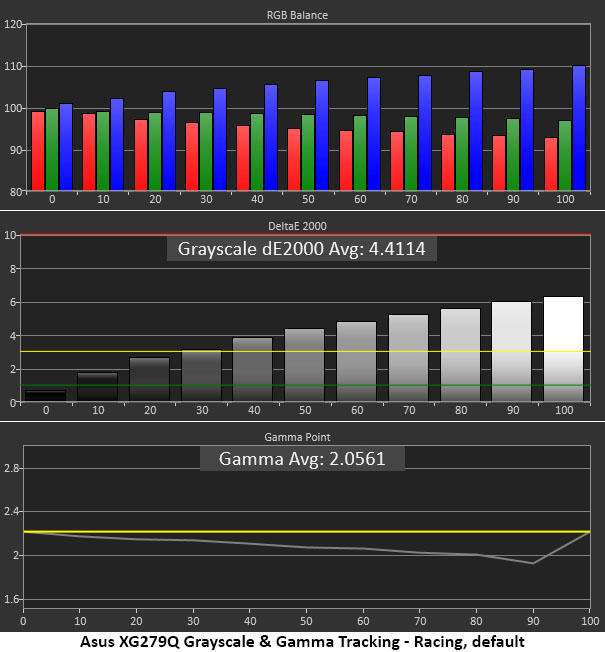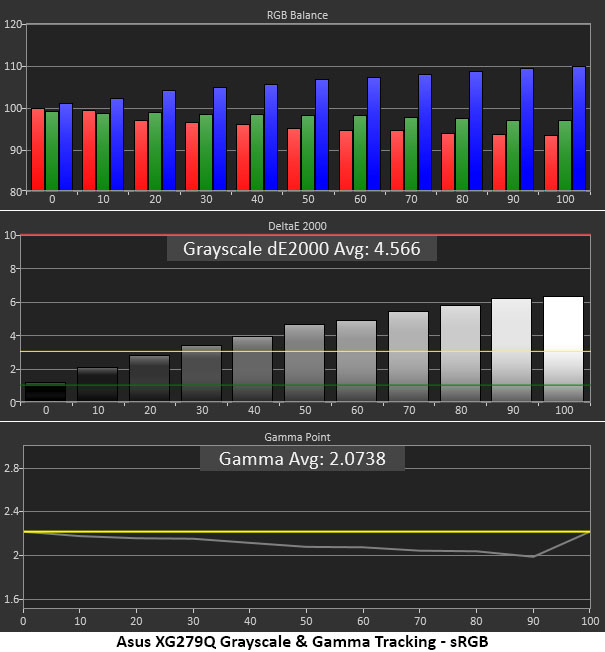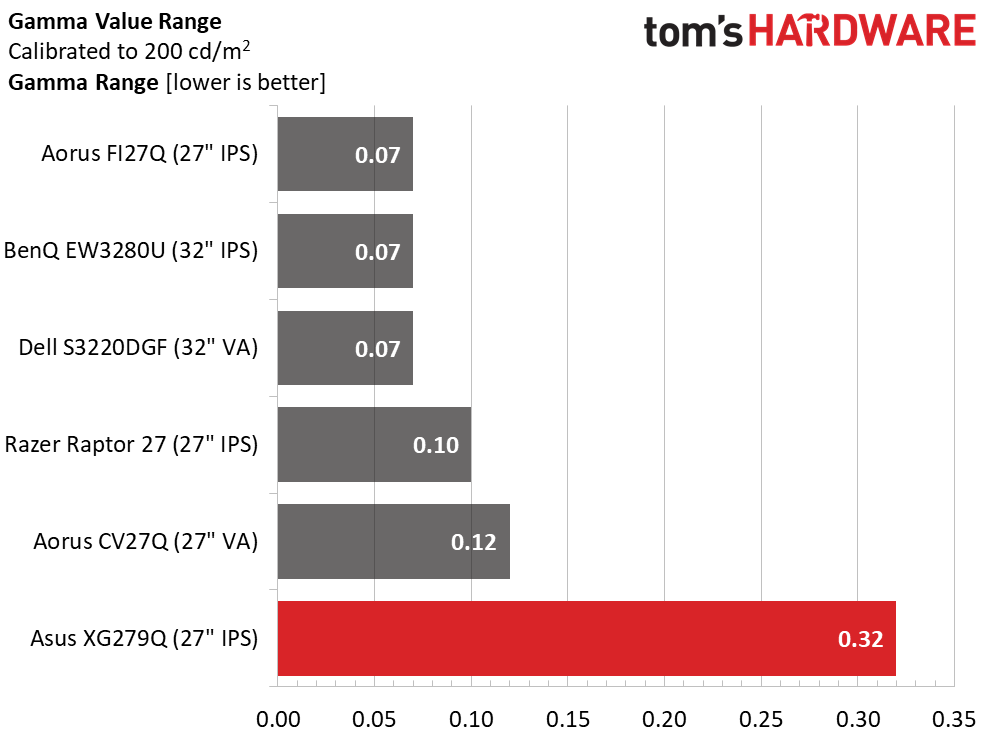Why you can trust Tom's Hardware
We took our baseline measurements in the XG279Q’s Racing mode. It allows calibration but we went to the user preset to have access to all controls. For sRGB purists, there is a dedicated mode, but it comes with limitations, as stated earlier.
Grayscale and Gamma Tracking
Our grayscale and gamma tests are described in detail here.



The XG279Q runs cool out of the box, showing errors from 40% brightness and higher. The dE values indicate the blue tint is visible to the naked eye. It makes the image a bit flat. Gamma is also too light, creating a washed-out appearance that also de-saturates color. There is room for improvement here.
Calibration fixes the grayscale issue nicely with a pro-level score of 0.539dE. It doesn’t get much better than that. By changing the gamma preset to 2.5 we’ve improved image depth considerably though shadow areas look a little undefined. Overall though, the picture looks much better with higher perceived contrast and greater color saturation.
The sRGB picture mode also runs cool and there is no access to the color temp or gamma controls. You have to accept the blue errors and light gamma. Brightness is also locked at over 300 nits which is fatiguing after a few hours of use. The best choice is to stick with Racing or User and enjoy the extra color for both SDR and HDR content.




The XG279Q takes the last two places in our out-of-box grayscale test. Both Racing and sRGB show a cool tint that measures 4.41dE and 4.57dE respectively. While these aren’t huge errors, other monitors can do better. With calibration, the User mode posts a superb 0.54dE score; pro-level performance. sRGB mode cannot be adjusted and is therefore unchanged.
Gamma doesn’t track in a straight line, so its value range is greater than the other screens. At the 2.2 setting, it’s too light, resulting in a flat image that lacks vibrance. At the 2.5 setting, it looks much better with a measured average of 2.33. If you do nothing else, we recommend changing the gamma for its impact on image depth.
Get Tom's Hardware's best news and in-depth reviews, straight to your inbox.
Color Gamut Accuracy
For details on our color gamut testing and volume calculations, please click here.



You can see that the XG279Q covers nearly all the DCI-P3 gamut. It comes up only a hair short in the green primary and actually extends beyond the perimeter for blue, magenta and red. Red is slightly undersaturated in the inner targets due to the light gamma. And the white point is a bit blue.
Our RGB and gamma adjustments have reduced visible errors significantly. Now red is a tad oversaturated, balancing nicely with magenta and blue. Yellow is right on target while green and cyan remain slightly under-saturated. Overall performance is excellent with good coverage and a vibrant color palette that works well for all content.
The sRGB mode is reasonably accurate. with slight under-saturation in red and small hue errors for cyan and magenta. Our main complaint about this mode is its light gamma and bright peak of over 300 nits. It’s only useful in very bright rooms at that level. We stuck with User and Racing for our hands-on tests.
Comparisons


Though the XG279Q is behind the other monitors in our gamut accuracy test, it still measures below the threshold of visibility for DCI-P3. sRGB is a little over the 3dE line due to its secondary color hue errors. But 2.60dE is an excellent score for any monitor. Again, we recommend using our settings or performing your own calibration to get the most out of your XG279Q.
DCI-P3 gamut volume is among the highest we’ve measured. Only a few monitors can deliver over 90% and the XG279Q manages 92.33% for both that and sRGB. Red, magenta and blue are especially well-saturated, which makes those colors stand out in real-world content.
MORE: Best Gaming Monitors
MORE: How We Test Monitors
MORE: All Monitor Content
Current page: Grayscale, Gamma and Color
Prev Page Brightness and Contrast Next Page HDR Performance
Christian Eberle is a Contributing Editor for Tom's Hardware US. He's a veteran reviewer of A/V equipment, specializing in monitors. Christian began his obsession with tech when he built his first PC in 1991, a 286 running DOS 3.0 at a blazing 12MHz. In 2006, he undertook training from the Imaging Science Foundation in video calibration and testing and thus started a passion for precise imaging that persists to this day. He is also a professional musician with a degree from the New England Conservatory as a classical bassoonist which he used to good effect as a performer with the West Point Army Band from 1987 to 2013. He enjoys watching movies and listening to high-end audio in his custom-built home theater and can be seen riding trails near his home on a race-ready ICE VTX recumbent trike. Christian enjoys the endless summer in Florida where he lives with his wife and Chihuahua and plays with orchestras around the state.
-
DZIrl Are there any tests of monitor speed using high speed cameras?Reply
1ms means black to white or gray to gray? Under what circumstances? -
ArmandB I'd probably buy a monitor from another brand. I bought a VG279Q and a month out it would no longer run at 144hz without artifacting and blinking on/off. After a dozen ridiculous emails with suggestions like running the monitor at 60hz, finally sending the monitor in for an RMA to only have it come back two weeks later obviously not having been worked on as it had the same exact problem and me even sending a video of the issue which shows it happens instantly and is completely repeatable, I have given up and taken the monitor as a loss.Reply
Normally I like Asus, I've used ROG motherboards for my last few gaming systems, and like their WiFi routers. But after dealing with how completely incompetent their support is I won't buy from them again. -
Rockismyth Great review. I just purchased this and will be referencing the review for calibration when it arrives. I've been using the ASUS ROG PG27VQ for four years now and absolutely love it. I just started looking into purchasing a second for a dual setup. This seems to build upon that, so I'm excited to see how well it performs in what I'm going to throw at it. Gaming, Adobe's Creative Cloud suite, web/software dev and more. FTR this is will be my fourth ASUS monitor.Reply -
tummybunny Still waiting patiently for HDMI 2.1 monitors that can accompany a new 2.1 GPU and console.Reply